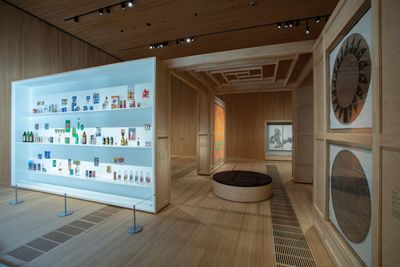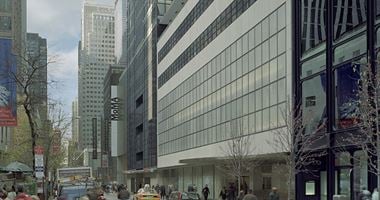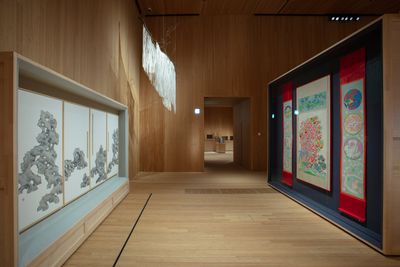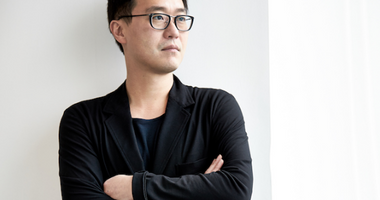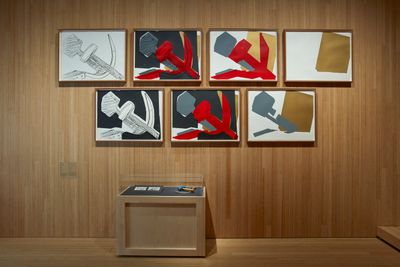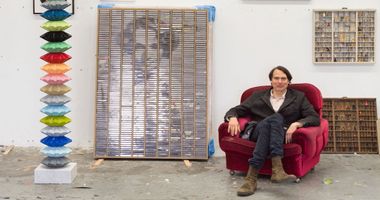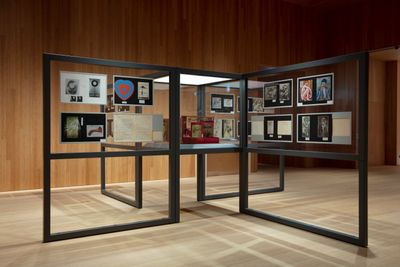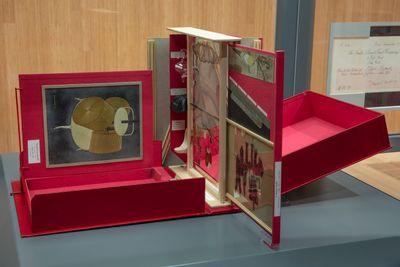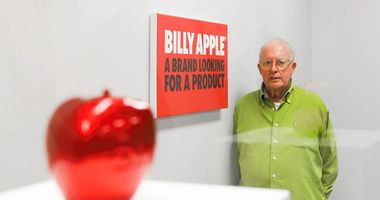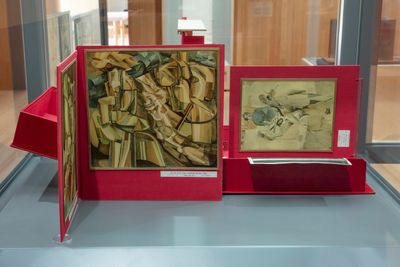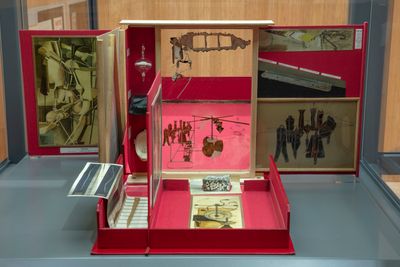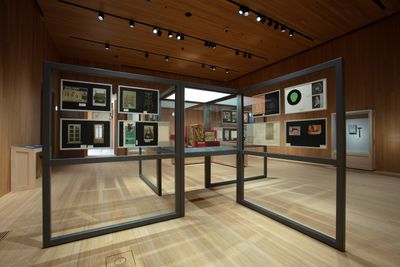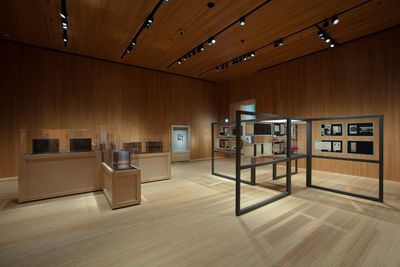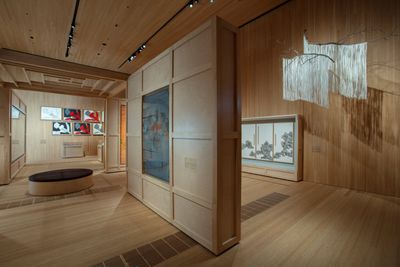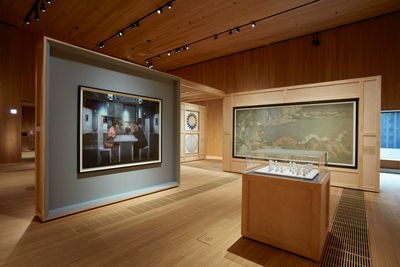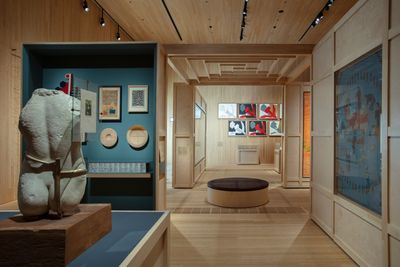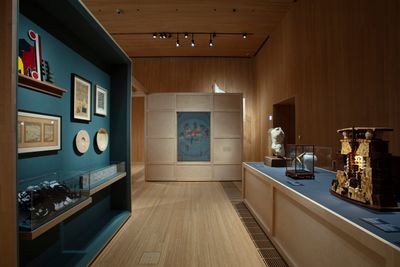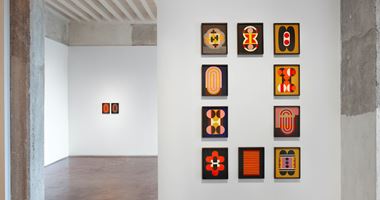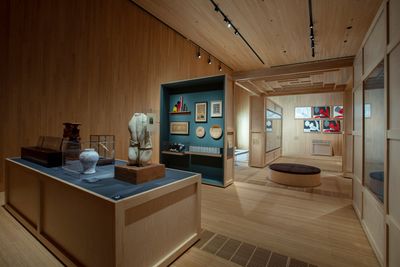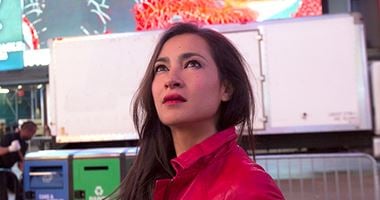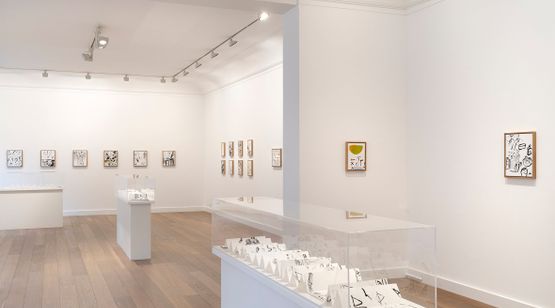The Dream of a Museum at Hong Kong's M+
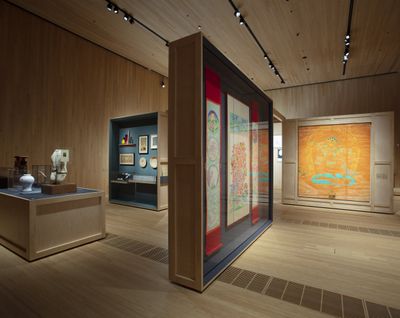
Exhibition view: The Dream of the Museum, M+ Museum, Hong Kong (12 November 2021–18 September 2022). Courtesy M+.
One doesn't enter a dream intentionally; one drifts into it. Like wandering into a garden: a meaningful meander in space and time. For the chronic insomniac, it might take years before the dream arrives.
At M+, the dream is the architectural grandeur of Herzog and de Meuron's central atrium: white paint and grey concrete bathed in the confluence of sunlight and cold fluorescent light. But beyond this space, flanked by ambiguous signage, is a completely different set of galleries, where split bamboo veneer-lined walls are bathed in a warm yellow hue.
The Dream of the Museum (12 November 2021–18 September 2022), unfolding in two galleries, begins in a wooden box: a non-white space that manifests the fundamental struggle of M+ as a young museum that—while beholden to the ideological aspirations of great modern art museums like MoMA, Centre Pompidou, and Tate Modern—aims to chart a pathway for visual culture beyond Western centrality.
A white cube decontextualises and transcends actualities. A bamboo cabinet, on the other hand, gives room for associations and analogies to exist against the rigidity of canon, styles, and historicisation.
Curated by Deputy Director, Curatorial and Chief Curator, M+, Doryun Chong and assisted by Hester Chan, Curator, Collections, and Ariadne Long, Assistant Curator, Visual Art, the exhibition's first chamber showcases Marcel Duchamp, John Cage, Yoko Ono, and Nam June Paik: four pioneers of Conceptual art, an art movement that began in the 1960s, which favoured the idea of the artwork over the finished product.
To start with this quartet establishes an authoritative canon in order to challenge it, take it apart, and expand its scope. At the core of this exultation are two key elements—the role of chance and the incorporation of found objects—that often intersect.
Frequently, chance encounters lead artists to rediscover readymades in their daily lives, and there lies the poetic serendipity and rupture that might initially elude viewers more accustomed to the dry, intellectualisation of conceptual art with a capital C.
Taking centre stage is Marcel Duchamp's From or by Marcel Duchamp or Rrose Sélavy (Box in a Valise) (1935–1941/1963–1966), conceived as a 'portable museum'.
The installation of Box in a Valise consists of a central glass vitrine containing an unfolded, red cloth-lined box with compartments holding miniature transparencies and reproductions of Duchamp's previous works.
Among them, Fountain (1917), a porcelain urinal, and Three Standard Stoppages (1913–1914), three non-functional measuring units created through chance by thrice dropping a one-metre-long string onto a horizontal plane.
Each side of the central vitrine extends into a double-sided Plexiglass stand with captioned image plates showing 16 leaves of flat Duchamp works, forming a four-armed windmill—a method of completely visible display that is believed to have been attempted for the first time.
Chong says the radial configuration is inspired by Duchamp's Coffee Mill (1911), a machine that holds the architecture of a functional instrument and the connotation of churning desire.
In keeping, The Dream of the Museum proposes a synthesis between the intellectual planarity and logocentric procedures of an institution and the sensuality, pathos, and rhapsodic jouissance of a museum.
Duchamp's box-museum is an intellectual allegory on the essence of a museum, after all, but its content is full of experimental humour, sexual innuendos, and linguistic puns. This duality is aptly reflected in the M+ display: the museum frames are clinical and didactic, but its geometric formation invites deliberate circumambulation and curious looking.
Arriving at M+ from the framer only a few days before the museum opening, immaculate new glass vitrines contrast with the cracked glass in The Bride Stripped Bare by Her Bachelors, Even (1915–1923) (aka The Large Glass), normally housed in the Philadelphia Museum of Art. The Large Glass was damaged after an accident in 1927, and the artist chose not to fix its traces.
Not all works are susceptible to human change, though. Yoko Ono's Painting to Hammer a Nail in (1961/1966/1988) is an 'instruction painting' later cast in impervious bronze: the object of a participatory work where viewers hammered nails into a wooden panel.
Thoughts of endings and transformation infuse Not Wanting to Say Anything About Marcel. (Plexigram I– VIII) (1969), created by John Cage with collaboration from Calvin J. Sumsion in tribute to Duchamp after his death in 1968.
Replicating the quadrilateral configuration of Box in a Valise, 64 acrylic 'plexigrams' form a play on the I-Ching hexagrams, a Taoist divination method featuring six lines of unbroken (Yang) and broken lines (Ying). In the installation, each glass contains alphabets chosen randomly through a process of chance augury in relation to the I-Ching.
The happenstance of numerology mutates Nam June Paik's hanging scroll Wurzel aus (1961), an early work of one sole square root sign written in marker pen, sequestering a mathematical symbol as readymade and abstract.
Following this opening gambit is the second chamber, where a window looks out to a courtyard flanked by brutal concrete slabs and metal-potted vines that have yet to climb the wall—an apt symptom of the West Kowloon Cultural District, where soft architecture requires time to grow.
Elaborating on the Box in a Valise installation in the first room, the spatial configuration multiplies into a quadrilateral mandala. Replacing human-sized glass vitrines are wall-sized wooden crates where artworks nest, hang, and spawn on both sides—four extending to each cardinal direction, crossing at a central cushioned pavilion.
Infusing this chamber is a yearning that underpins the practice of the Chinese Song literati: for encounters between culture and nature. Suspended high in the right corner is Lee Seung-Taek's Paper Tree (1970s): tree branches where ritualistic white paper strips hang and shimmer in the airflow.
A notable absence of oil on canvas exults the primacy of a non-Eurocentric materiality in relation to the relevance of ink art in Asia. An aqueous volume suffuses Hao Liang's ink on silk Eight View of Xiaoxiang – Dazzle (2015) assembles various forms of mountain and stones recorded in Chinese classical art history. While Huang Yongping's Dust (1987), a painting scroll unravelling from a wooden box while thick layers of dust gather over it, is a landscape painting by other means.
In A Requiem: Theater of Creativity / Self-portrait as Marcel Duchamp (Based on the photo by Julian Wasser) (2010), Morimura Yasumasa restages an image of Duchamp's post-artist life as a chess player.
Playing both artist and female nude, Yasumasa's gender-bending act criticises the heteronormativity and misogyny in Duchamp's practice, while positing the pioneer of Conceptual art as a 'found object'. As is the case in Danh Vō's Untitled (2018), where a glass slide of Duchamp's L.H.O.O.Q is grafted onto an ancient marble torso of Venus where a shoulder should be.
Vō's work is among the five sculptures positioned on one table, some of them tapping into legacies of the ancient literati, who often travelled for imperial postings as artists, writers, and curators go abroad for residencies, exchanges, and jobs today.
The temporary studio becomes an imaginary and mnemonic space to display multiple belongings in Po Shun Leong's Landscape Box (2009): an aide-memoire of eclectic roots and wayward journeys. In a treasure chest crafted with precious woods, an Escheresque architecture rises vertically through twisting Baroque columns, Romanesque ornaments, Chinese rock gardens, and Aztec and Mayan motifs.
Likewise, Ni Youyu's Landscape Case (2009) turns the interior of a traditional wooden scroll box into a speculative three-dimensional topographical map. Annotating strewn rocks, sticks, and miniature models of ruinous pavilions, is calligraphy describing the existing and imagined place names from classical Chinese verse into this fictional landscape.
Extending these cartographies on a salon wall are the modernist shapes of Lubna Chowdhary's Certain Times V (2019), a jagged group of colourful ceramic tiles that rest on a shelf, were drawn from different metropolitan skylines.
Nearby, Ettore Sottsass' Offerta A Shiva (Ff No. 538) (1964)—two ceramic puja thali ceremonial prayer plates in Hindu rituals—were created as offerings to Shiva after convalescing from malaria while travelling in India.
In musical terms, if the first chamber of this exhibition articulates the classical theme of this show, the second room reinvents in polyphonic variations: a thesis framing conceptual art as an unstoppable development that ripples across temporalities and geographies.
The subversive mimicry of traditional Persian or South Asian visual traditions pervades in Shahzia Sikander's miniature painting of a wedding scene in Untitled (Baraat) (1992), and Siah Armajani's Dictionary of Numbers (1957), a Persian bound album page where lines of disorderly numbers fill and spill out of the inner frame.
An unwieldy pile of knotted black cotton ropes radiates from the coiled and bound pages of an open notebook in Hassan Sharif's Cotton Rope No.7 (2012), forming a dense network of nodes, lines, and frays, while Etel Adnan's Japanese accordion album Point Reyes n°2 California (1989) is filled with scribbles vaguely resembling Arabic text or titular landscape.
Every work speaks to an undecipherability in acts of conceptual abstraction not arrived at through European modernism but endemic to each creator's language and world, where the 'idea' binds with different material cultures. No linear genealogy or master narrative can be drawn. Just fluid trajectories that are rhizomic, non-hierarchical, and unruly. —[O]


